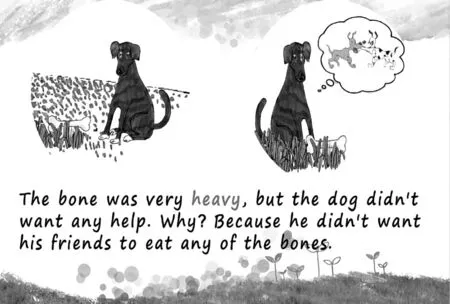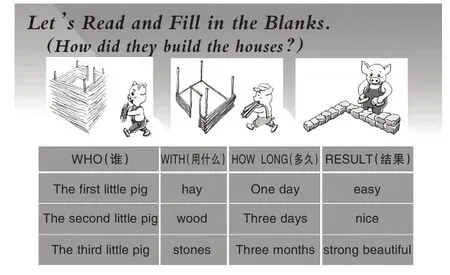小学英语故事教学问题分析与策略探寻
○张爱霞
《义务教育英语课程标准(2011年版)》明确阐述了故事教学关于学生在听、说、读、写、玩演视听方面的语言技能要求。不同版本的小学英语教材都设置了故事教学板块,但有些教师对故事教学定位不准,缺乏必要的教学策略,导致小学英语故事教学问题重重。本文结合具体课例,对故事教学中的常见问题进行梳理,并提出相应的解决策略。
【教学回放】
教学内容:Billy Bee故事教学,课件呈现第三张图片。
T: Boys and girls,Please look at the picture 3. Benny Bee and Billy Bee are talking.What are they talking?
Ss: How far is it?It’s about 20 kilometres.
T: How far“多 远”. For example. How far is it from Beijing to Shijiazhuang?It’s 278 kilometres. Read after me!
Ss: How far is it from Beijing to Shijiazhuang?It’s 278 kilometres.
...
【诊断分析】
在小学英语故事教学中,故事作为重要载体,为学生学习语言知识、提升语言技能提供了内容和情境。我们要充分利用故事图文并茂、富含情境、语言重复性高等特点,开展与故事相关的教学活动,促进学生语言能力、思维能力等多种素养协同发展。但在实施教学过程中,由于教师对其内涵及原则把握程度不同,实施效果也不尽相同。本节课,教师就上成了复习课,挖出本单元重点句型“How far is it?It is…”来讲解,导致失去了故事教学本身的意义,更不能激发学生的阅读兴趣。
【教学重构】
T: Boys and girls,first,Let’s listen to the story and answer the questions. How many bees?Who are they?
S: Three bees.They are Benny bee,Billy bee and the queen bee.
T: Please look at the picture 3. Listen,what are they talking?Can you imitate it?
S1: How far is it?
S2: It’s about twenty kilometers.
...
T:Good! Next time choose your favourite character and act it out.
教学Billy Bee时,我们可以把语言知识放在听故事、读故事、演故事以及相关的活动中。学生认真听故事,回答问题How many bees?Who are they?初步了解故事大意;学生读故事进行图片环游模仿Billy Bee 和Benny Bee 对话的语音语调,培养英语语感;Act out the story 更是让学生学会把握故事的主线,结合自身肢体语言呈现自己对故事的理解。
【教学回放】
教学内容:阅读欣赏The Dog and the Bone

T: Today,we’ll learn the storyThe Dog and the Bone. Look at the pictures. Where was the dog?
S1: The dog was taking a walk in the city park.
T: What was the dog see?
S1: He saw a bone in the grass.
T: Look at the picture 2. What was the dog thinking?
S2: The dog thought he didn’t want any help.
T: Why?
S2: Because he didn’t want his friends to eat any of the bone.
...
【诊断分析】
上述教学片段,教师不能将故事的设疑、语言、图片创设于文本学习的大情境中,忽视图片的观察和引导,忽视问题的启发性,浅层次提问诸如“Where was the dog?What was the dog doing?”较多,就句子讲句子,不利于学生思维技能的提升,无法达成大情境下的设疑感知、语言感知和图片感知,导致学生语言输入出现了问题。
【教学重构】
T: Hello,boys and girls. Today I want to introduce my pet to you. Listen,what animal is it?
S: It’s a dog!
T: Oh,my dog is barking! What happened?Well,he saw a bone. He ran to the bone. What a lovely dog! Today I will share you a story about the dog and the bone.
T: Boys and girls,from this part,we can see: Where was the dog?What was the dog doing?
S1: He was in the city park. He was taking a walk.
T: What did the dog see in the grass?
S2: He saw a bone.
T: Let’s guess! What did the dog do?
S3: He would share the bone to his friend.
T: Maybe.So we choose A. Oh,no! He hid the bone. Let’s see what happened!
T:The bone was very heavy,but the dog didn’t want any help. Why?
S4:Because he didn’t want his friends to eat any of the bones.
T:You can imitate like this.“I can carry the bone to the forest! It is far from the park. My friends can’t find me there.”
教师在故事教学中提供视觉、动作和声音的支持,让学生自己去解码、发现和构建语言的意义;在学生对故事充分感知的基础上,教师引导学生进行预测、假设、推断等思维活动,学生思维技能得到了锻炼。通过情景化的图片和惟妙惟肖的语言“Give me your bone! ”he barked at the dog in the water. 学生积极进行角色体验和模仿,为语言的输出——讲故事、演故事、续编故事做好充足的准备。
【教学回放】
教学内容:阅读欣赏Three Little Pigs
T: Look at the first picture. There were three little pigs. Another one,Who was she?
S1: Maybe she was their mother,their sister. And grandmother maybe.
T: What were they doing?
S2: They were saying goodbye.
T: Read picture 2~4 with questions.What can we see?What were they doing?
S3: We can see three little pigs building their houses.
…
【诊断分析】
图片环游作为故事教学中重要的策略,是教师和学生共同阅读故事合作建构意义的过程。在这个过程中,教师将文本故事演绎成生活故事,以问题为引导,通过主题图启发学生主动观察、预测思考,分享个人经验。在不断推测和阅读中发现问题、分析问题和解决问题,以此来培养学生的批判性思维。图片环游的教学方式与传统的语言知识和阅读理解教学完全不同。上述教学片段中,教师只停留在图片环游观察的表面,仅仅是限于提问以who/where/when/what 引导的问题,而不能上升到“why?Why do you think so?”这些批判性的问题上,使学生停留在浅层阅读的水平。
【教学重构】

T:Now Let’s read the text and fill in the blanks. What did the little pig build the house with?How long did the little pig build the house?What was the result?
S1: The first little pig used hay to build his house. It took him one day.
S2: The second little pig used wood(木材)to build his house.It took him three days.
S3:The third little pig used stones to build the house. It took him three months.
T: These three houses,which one do you like?why?You can think about it.
…
教师要求学生根据有限的图片信息进行观察分析和预测,引导学生在分析问题和解决问题的过程中展开阅读,应用阅读技巧和策略提升阅读能力。
小学英语故事教学,教师要充分利用教材资源,精准定位学习目标,运用激发兴趣、充分感知、适度拓展的教学机制,即在问题激趣、活动激趣、情感激趣基础上,适时运用情景感知、图片感知、语言感知让学生充分感知故事,以达成故事教学的思维拓展、文化拓展和生活拓展,从而提升学生的阅读核心素养。

